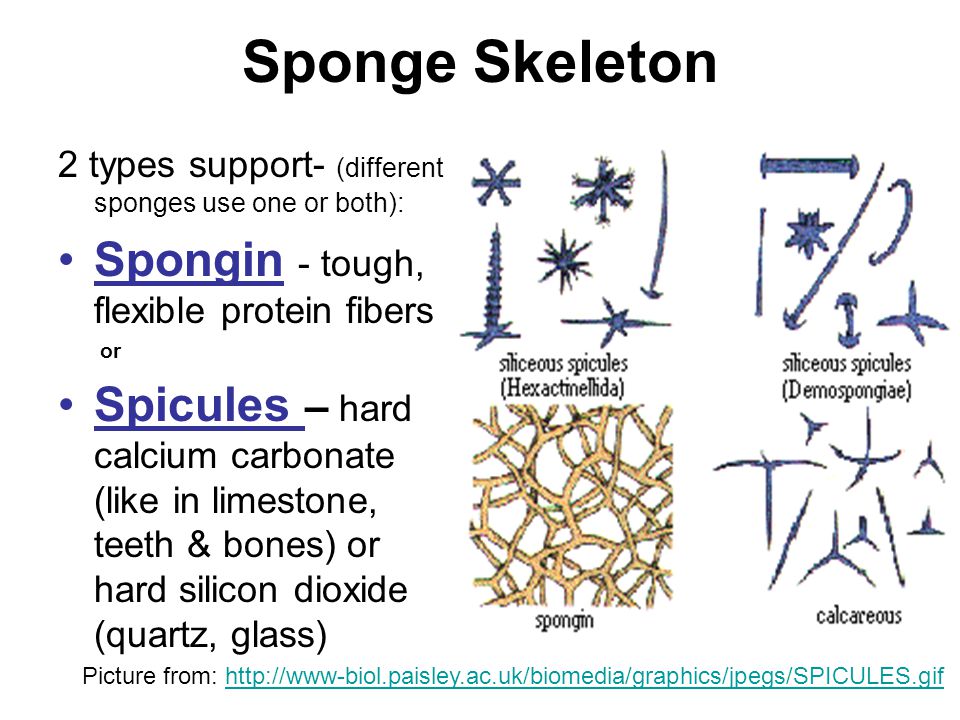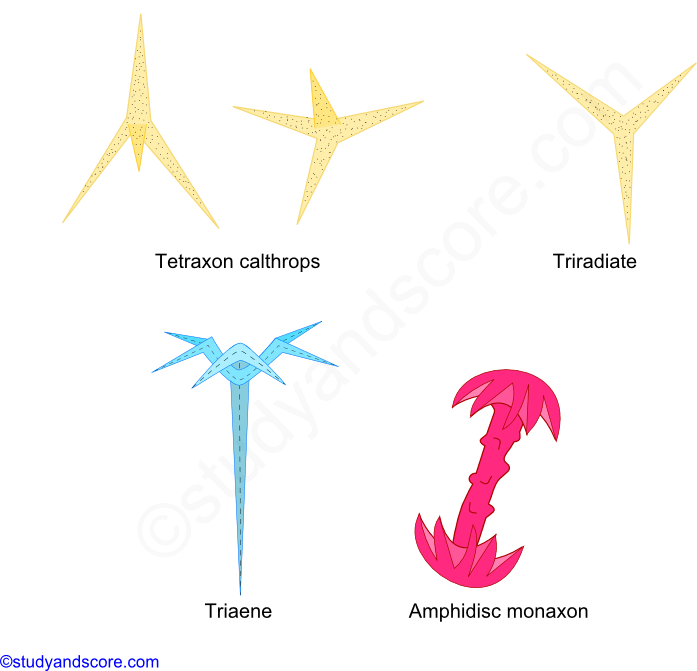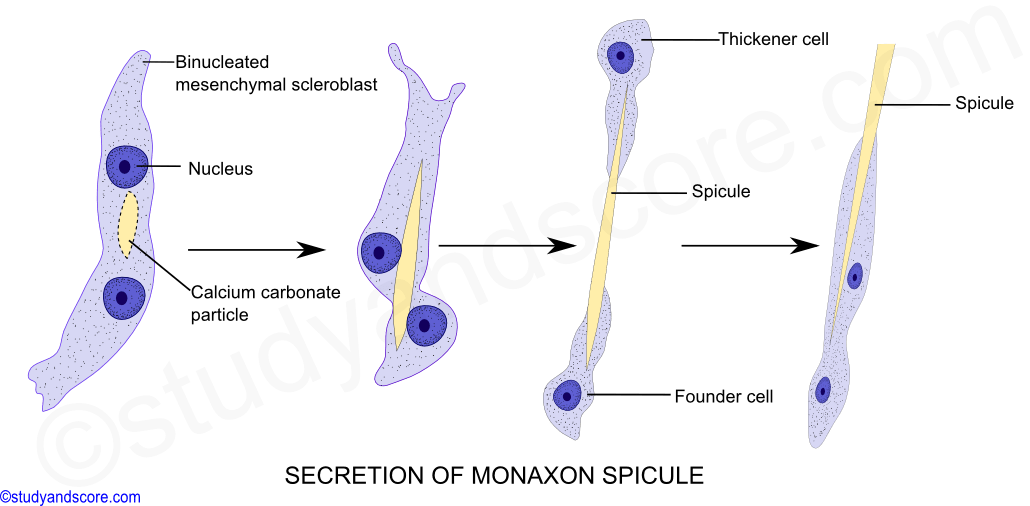Ascon sycon and leucon. Softer sponges spongin flexible protein fibers p.
Those in the Demospongiae Lithistida form a heterogeneous group in which irregularly branched spicules desmas form a compact skeleton.

. O Hydrostatic skeletons o Exoskeletons o Endoskeletons Hydrostatic Skeletons. The skeletons of each of the major poriferan groups are distinctive and have been used to reconstruct their evolutionary. Skeleton is of siliceous spicules which are triaxon with six rays.
Calcarean sponges of order Pharetronida have skeletons formed by an amorphous mass of calcium carbonate with which few spicules are associated. The sponges possess an endoskeleton in the form calcareous spicules made up of calcium carbonate siliceous spicules made up of silica and spongin fibres. So the correct answer is Endoskeleton.
The Demospongiae the most diverse containing 90 percent of all living sponges Hexactinellida the rare glass sponges Calcarea calcareous sponges and Homoscleromorpha the rarest and simplest class only recently recognized. Chicken Liver Sponge has 2 different habits separated by color and habitat. A skeletal system is necessary to support the body protect internal organs and allow for the movement of an organism.
In harder sponges the skeleton is made up of spiny spicules. Ascon sponges are the simplest and least common sponge body from. In some the spicules are fused to form a lattice-like skeleton.
Types of Skeletal Designs. Sponges have a simple skeleton. Among the four sub-clades of Porifera three Demospongiae Hexactinellida and Homoscleromorpha produce skeletons of amorphous silica and one Calcarea of magnesium-calcite.
Up to 24 cash back There are three types of sponge body forms. There is no epidermal epithelium. Spongin fibres are composed of a silk-like scleroprotein.
As discussed in Sponges. These sponges have multiple ostia this is where water enters the sponge and only have one osculum where water exits the sponge. Spicules are formed by carbonates of lime or silica in the form of needle like pieces.
They are called glass sponges. The Skeletons of Sponges. Choanocytes line finger-shaped chambers.
Different skeletons have adapted to different methods of locomotion The various types of skeletons are an adaption to the environment in which the animal lives. These are the soft elastic sponges some of which are harvested for household and commercial use. Air land or water The different types of skeletons are.
They are cylindrical or funnel-shaped and are found in deep tropical seas they grow up to one metre. Glass sponges have spicules made of silica. SPICULES The spicules constitute major part of skeletal system which are secreted by special mesenchymal cells called scleroblasts.
Appendicular skeleton bones of the limbs shoulders and pelvic girdle. About 80 percent of sponges belong to the class Demospongiae and have a skeleton made of spongin. Axial skeleton bones of the skull vertebral column thoracic cage.
Some Demospongiae found mainly on the coral reefs possess a compact. There are three different skeleton designs that provide organisms these functions. Pinacoderm consists of porocytes cells which bear openings called ostia.
These are the small spicules occurring interstitially. The three classes of sponges are shown in Figure 4. Harder sponges spicules made of calcium carbonate or glasslike silica.
These are larger spicules constituting main skeleton of sponge body. The human skeleton is composed of more than 200 bones. Softer sponges have an internal skeleton made of sponging a network of flexible protein fibers.
On the basis of number of axes and rays. Taxonomists group sponges into three types based on the composition of their skeletons. 665 What type of nervous system do sponges have.
Choanoderm is composed of choanocytes or collar cells. Characteristics and Classification sponge classes are based on the composition of the spicules. Sponge skeletons are made up of hard rod-like projections called spicules and a protein called collagen.
It has a dark brown to walnut brown or beige color. A few species sponges lack a skeleton altogether. Skeletal structures of sponges are spicules and spongin fibres.
In some species the spon-gin is reinforced with spicules of silica. As a whole poriferans have diverse skeletal elements including calcareous laminae organic filaments and siliceous and calcareous spicules. Most sponges produce skeletons formed by spicules structural elements that develop in a wide variety of sizes and three dimensional shapes.
The base and inner tissue are light beige to buff and specimens growing in dark areas may be pale. Since there are no visceral organs in the skeleton of sponges their skeleton can not be categorised into external or internal category. Spicules may occur in several forms like the simple rod form or in the form of forks anchors shovels stars plumes etc.
Sponges are classified according to the composition of these spicules and therefore the skeleton. Describe the different types of sponge skeletons. The approximately 8550 living sponge species are scientifically classified in the phylum Porifera which is comprised of four distinct classes.
Whether youre a person or a sponge you have whats known as an endoskeleton a hardened internal skeleton. Hydrostatic skeleton exoskeleton and endoskeleton. Sponges like all animals possess some sort of a skeleton that gives their bodies shape.
The choanocytes have collar of microvilli around the flagellum. The human skeleton is composed. Chicken Liver Sponge also known as Chondrilla Nucula.
Spicules made of calcium carbonate or silica are secreted by cells called sclerocytes. The body wall of the sponges consists of two epitheloid layers the outer pinacoderm and the inner choanoderm. Calcareous sponges have spicules composed of calcium carbonate.

Phylum Porifera Skeleton Of Sponges Spongin Fibers And Spicules Study Score

Chapter 33 Porifera Sponges Ppt Video Online Download

Phylum Porifera Skeleton Of Sponges Spongin Fibers And Spicules Study Score

0 Comments